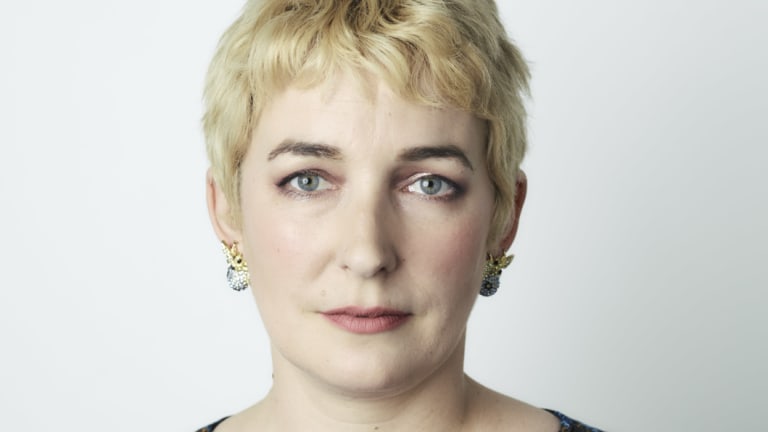
There have been only a handful of times in my life where I felt truly “seen”: one was my first visit to San Diego Comic-Con, and the other was my diagnosis, at 36, of autism spectrum disorder (ASD).
After a lifetime of feeling distinctly different, I was so thrilled to finally have answers that I half hoped the consulting psychologist delivering my results might tack a “congratulations” on to their assessment.
Clem Bastow knew she felt different, but it took until the age of 36 that she got a diagnosis.Credit:Kristoffer Paulsen
It was a series of feedback notes on my screenplay drafts that led me to take the plunge and seek assessment. Each script assessor agreed my work was well plotted, and very funny, but they’d pepper me with questions about the characters: Why does X act like this? How does Y feel in this scene? I would grip the chair, white-knuckled, trying my hardest not to yell “I DON’T KNOW!”
As I thought deeply about my experiences, more questions emerged. I wondered why I felt confused and dizzy in busily-decorated public spaces, and shirked from certain sounds that others couldn’t hear.
Why could I master some complex skills with laser-like focus and yet I couldn’t understand if someone was flirting with me? And why is it so damn satisfying to pat a bag of rice??
Now, with the clarity of a diagnosis, I see my entire life through a prism of understanding. I have never felt more comfortable being myself, and am a proud and happy autistic woman.
This experience of clarity is common to many diagnosed later in life. “Girls and women continue to be underrepresented in autism prevalence data,” Fiona Sharkie, CEO of Amaze, tells me. “The estimated ratio of autistic boys and men to autistic girls and women has recently moved from 4:1 to 3:1.”
ASD presents differently in girls, and male-biased diagnostic criteria meant many girls were denied a diagnosis, or misdiagnosed completely. This failure to diagnose and support autistic females has a huge impact not just on them but their families and communities.
“Many autistic girls and women are not receiving the supports and services they need and are at increased risk of abuse, financial hardship and social isolation,” Sharkie says. “Diagnosis is also important to understanding how to support girls, particularly through puberty and in relation to other conditions such as eating disorders and other mental health issues.”
The archetypal autistic person, if we take popular culture as gospel, is an awkward, white male genius type; Sheldon from Big Bang or Raymond from Rain Man.
Autistic girls and women, who may be confident socially (but collapse behind the scenes), don’t fit the mould. They may even be accused of lying or attention-seeking.
Natasha Staheli from Yellow Ladybugs, a community group dedicated to the support of autistic girls and women, is well aware of this issue. “Many autistic women have spent most of their life wearing a ‘mask’, and fly under the radar for the same reason,” she says. “We need to believe them when they speak of their challenges and their particular support needs.”
Consequently, it’s still something of a surprise when a woman—especially a high-profile one—reveals she is autistic. After Anne Hegerty, The Chase’s Governess, discussed her ASD on I’m A Celebrity, the UK’s National Autistic Society’s website crashed.
It's through finding their tribe that Autistic girls and women can start to feel connected and valued, which can make a profound difference.
When Hegerty assured her surprised co-star “if you saw my house, you'd know there was something very wrong”, I cheered in recognition.
Like many autistic people, I have put so much effort into passing in the neurotypical world—an experience that autistic scholar Temple Grandin likened to being “an anthropologist on Mars”—that my room (and diary) is often a bombsite.
Through all this, diagnosis itself is a privilege; many members of the so-called “lost generation” of autistic females must be content to self-diagnose and seek peer support.
“There are many barriers that prevent women from accessing a formal diagnosis, including financial cost and the difficulty in finding professionals who understand how autistic females present,” Staheli says.
“It is through finding their own tribe that autistic girls and women can start to feel connected and valued, which can make a profound difference to their sense of wellbeing.”
Clem Bastow reminds us 'if you've met one autistic person, you've met one autistic person' ... not them all.Credit:Kristoffer Paulsen
Research conducted by Amaze this year found that while 85% of the community has a personal connection to an autistic person, just 4% of autistic people believed people in the community knew how to support them.
As Sharkie says, however, “every person has the power to create a more inclusive world, simply by learning about autism and making small changes to their own behaviour.”
So, here’s somewhere to start: listen to your autistic friends and relatives. Don’t say things like “Isn’t everyone a bit ‘on the spectrum’?” Watch Are You Autistic? on iView. Unlearn media-led misconceptions about autism. Turn down the heater (please).
And remember: if you’ve met one autistic person, you’ve met one autistic person.
